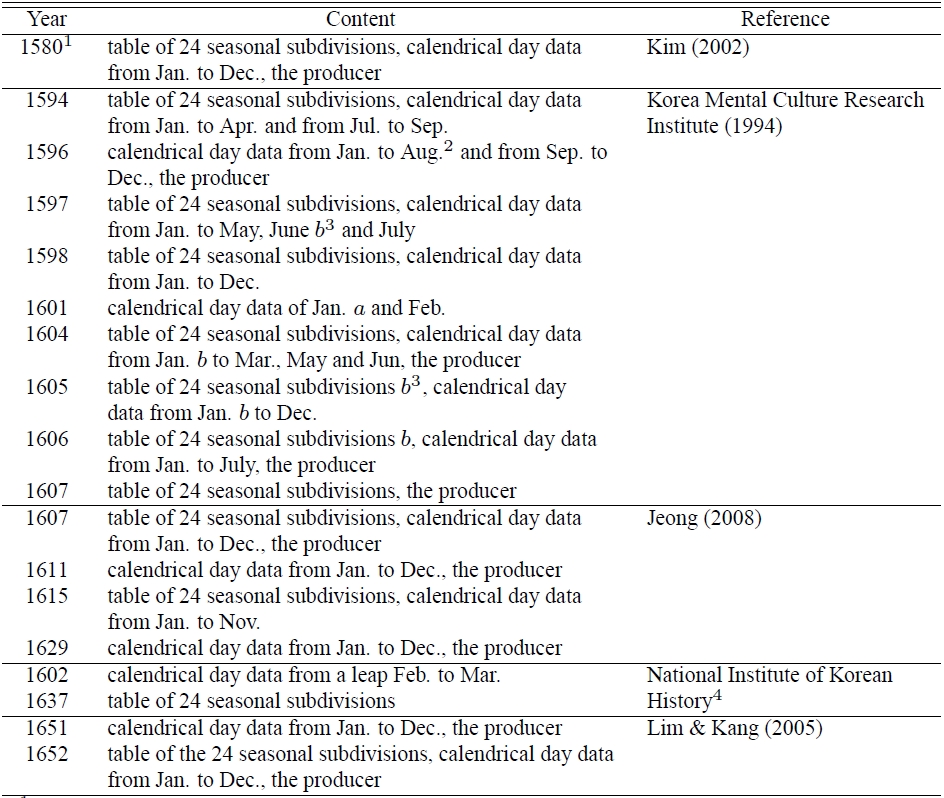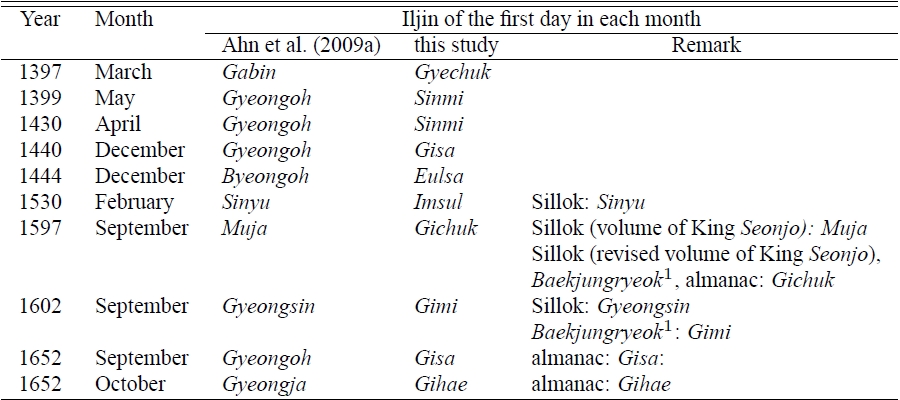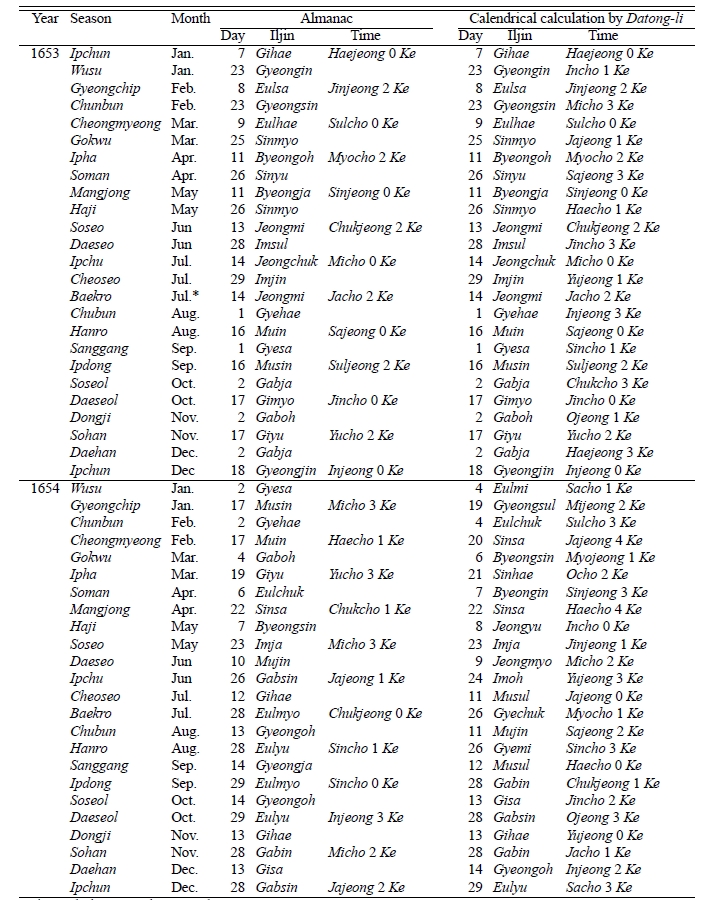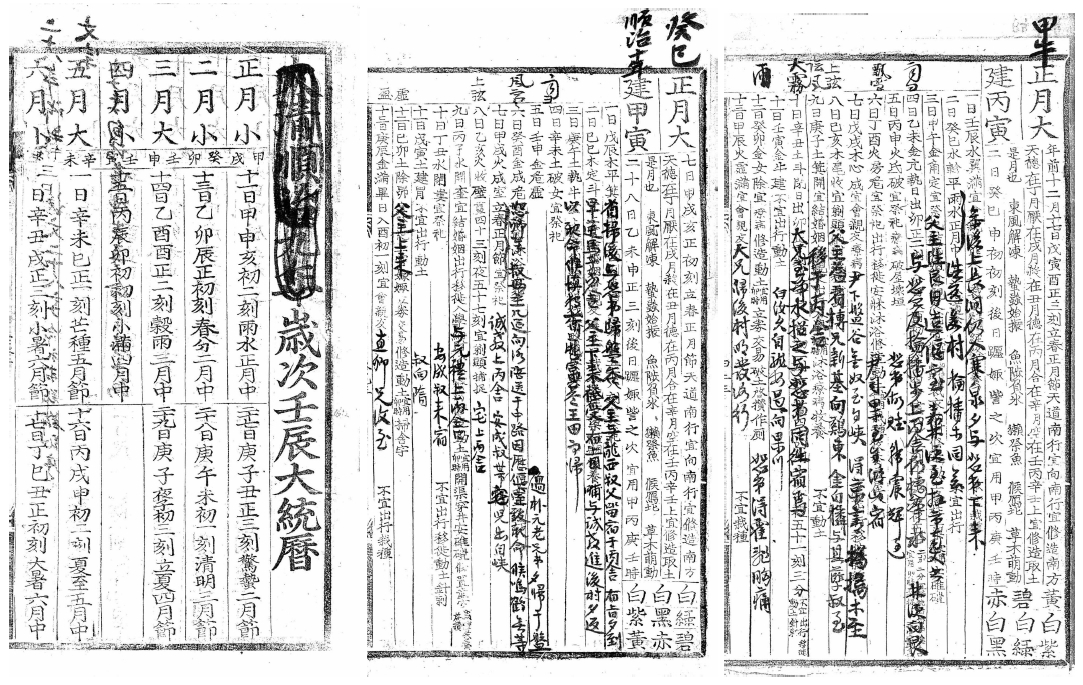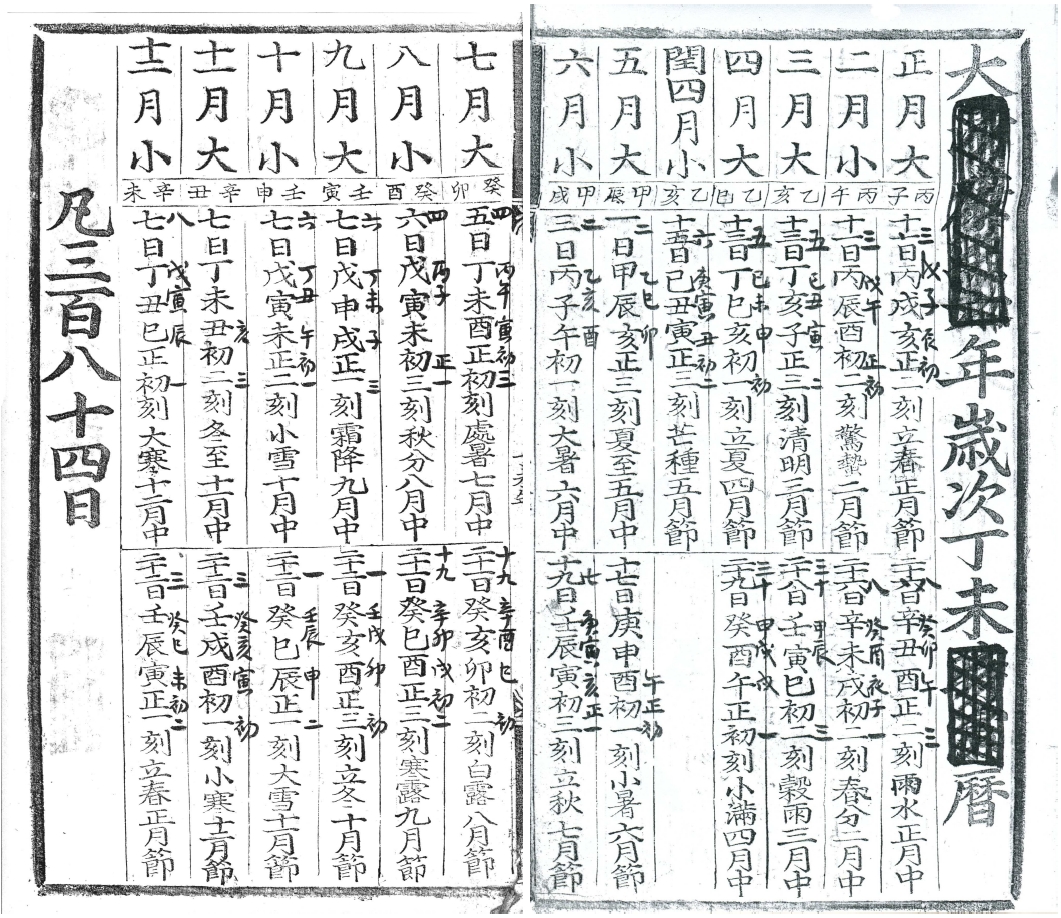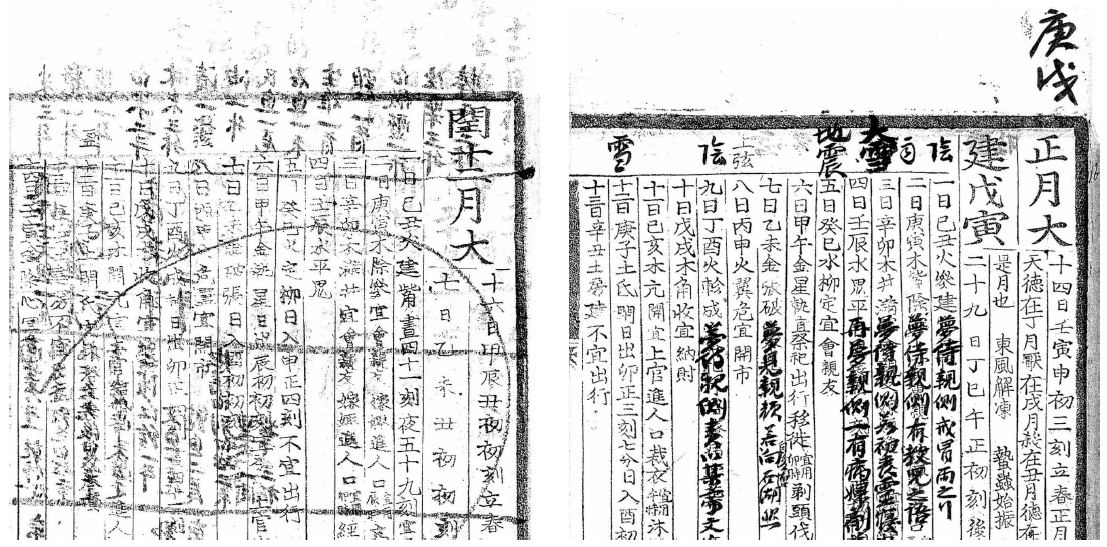Datong-li is a calendrical method of the Ming dynasty in China (1368 ∼ 1644) and there are two versions of 'Musin Datong-li' made by Liu, Ji on Eulmi Dongji in 13681) and 'Datong-lifatonggui'' made by Yuan, Tong in 1384 (Zhang 1971). Although there are slight differences between two calendars such as the fact that the epoch of the former is 1281 (Sinsa year) while that of the latter is 1384 (Gapja year), both are fundamentally the same calendrical methods based on Shoushili (Lee 1996). It is known that Datong-li began to be used in 1370, the 19th year of the reign of King Gongmin of the Goryeo dynasty (Jeon 1974, 1998, Lee 1996, Lee 1997b), based on the records of Goryeo-sa etc. On the contrary, Yu (1982) and Lee (1988) infer that Datong-li could not be adopted because the Goryeo dynasty was declining at that time.
According to Sangwi-go (Volume) of Jeungbo-munheon-bigo (Explanatory Notes of Literary Document) (King Sejong The Great Memorial Society 1978), the Joseon dynasty used Datong-li from the beginning of the dynasty. However, the calculation methods such as solar/lunar eclipses and five planets were not known. Hence, King Sejong ordered In-Ji Jeong, Cho Jeong, and Heum-Ji Jeong to study the methods, correct Taiyang-tonggui, Taiyin-tonggui and so forth, and compiled Chiljeongsan-naepyeon (Yu et al. 1973; hereafter Naepyeon). Currently, the oldest available edition of Naepyeon is the one compiled by Sun-Ji Yi and Dam Kim in 1444 (Lee & Kim 1444). The series of tonggui books such as Datong-liri-tonggui, Taiyang-tonggui and Taiyin-tonggui etc compiled by the same authors were also preserved in the Gyujanggak library. According to the work of Lee (1988), these tonggui series became the basis of the compilation of Naepyeon. Naepyeon is basically the same line of calendrical method as Datong-li (therefore, Shoushi-li). Moreover, the titles of currently available astronomical almanacs at that time are written as Datong-li (see Kim 2002, Jeong 2008).
Shixian-li made by Adam Schall et al. became to be enforced in the Ching dynasty of China from 1645 (Lee 1985). In Joseon, the calendar became effective from the 4th year of the reign of King Hyojong (1653) after over ten years efforts of Yuk Kim, the head of the Bureau of Royal Astronomy and Sang-Beom Kim, a staff of the Bureau (King Sejong The Great Memorial Society 1978). Therefore, it is known that Datong-li was used until 1652, the 3rd year of the reign of King Hyojong (Lee 1997a, Yu 1999, Lee 2008). In recent, Jeon (2002, 2004) pointed out that Shixian-li was introduced in 1654, i.e., Datong-li was used until 1653, based on the records of Joseon-Wangjo-Sillok (Annals of Joseon dynasty; hereafter Sillok) (also see, Ahn et al. 2000).
As such, the introduction year or the period of the use of Datong-li completely depended on literary records without any verification through astronomical almanac or calendrical calculation. In this paper, we develop a computer program to calculate calendar days by Datong-li and investigate the period of use of Datong-li in Korea by the analysis of astronomical almanacs and records of old literatures. In section 2, the calculation of calendrical days by Datong-li was briefly explained and compared it with extant Datong-li almanacs. We discuss the introduction year and the period of the use of Datong-li in sections 3 and 4, respectively. The literary records related to Datong-li were verified in section 5. Finally, we summarize in section 6.
1)According to our calendrical calculation by Datong-li, the sexagenary circle of the winter solistice of 1367 (23 November) not 1368, is Eulmi
As mentioned earlier, Shoushi-li, Datong-li and Naepyeon are basically the same calendrical methods and differences between them are as shown in Table 1 (refer to Lee 1988). As shown in the table, Naepyeon is the same as Datong-liri-tonggui and Musin Datong-li except for Xiaochangfa. We, therefore, refer to Naepyeon translated into Korean by Yu et al. (1973) in order to calculate calendrical days by Datong-li. There are two editions in Naepyeon: one is appended to the volume of Sejong in Sillok (hereafter Sillok edition) (King Sejong The Great Memorial Society 1990) and the other is compiled by Lee and Kim in 1444, printed with Gabin fonts and preserved in Gyujanggak library (hereafter Gyujanggak edition) nowadays. Datong-ilri-tonggui compiled by the same authors (hereinafter tonggui edition) are also preserved in Gyujanggak. The former, Sillok edition, was translated into Korean by Yu et al. (1973). In the course of calculating calendrical days, we checked constant values presented in these three editions and found Gyujanggak edition, in general, had relatively more errors than Sillok edition.
Because the translated book by Yu et al. (1973) also contains calculation examples referring to the books of Jeongmyoyeon-gyeosik-garyung (examples for the calculation of solar and lunar eclipses occurred in 1447) and Gyeosik-chubobeob (calculation method for the solar and lunar eclipses), we will not describe detailed processes of calendrical day calculation in this paper. Instead, we will briefly mention on a few issues. First, the translated book is explaining that 'according to Gyeosik-chubobeob, the difference between the lunar and solar movements (in unit of degree) should be divided in the process of obtaining the real first day from the mean first day of a month and this method is the same in Datong-li'. However, we found that when only the lunar movement was divided, the results were consistent with extant almanacs. Second, the method, adopting nowadays (refer to Korea Astronomy and Space Science Institute 2008) and mentioned in Naepyeon, was used in inserting a leap month. That is, we apply the intercalation method itself in the calculations of calendrical days differently with previous studies which were obtained the leap month information from historical documents. As a result, we find that all leap months were perfectly consistent with previously known leap months. Finally, when Xiaochang-fa was applied to calculate calendrical days, there were some disagreement on leap months. Thus, we do not use Xiaochang-fa in this study.
Table 2 is a list of Datong-li almanacs of the Joseon dynasty period used in this study. In the table, 1, 2 and 3 columns are year, content of the almanacs and reference, respectively. At present, the oldest almanac is Gyeongjin year (1580) which was designated as treasure no. 1319 and is currently stored in the National Folk Museum of Korea (Kim 2002). Datong-li almanacs are generally composed of a table of 24 seasonal subdivisions, a map showing the directions of evil spirits (hereafter, Yeonshinbangwi-do), the calendrical day data of each month covering two pages (one for the 1st day ≫ 13th day and the other for the 14th day ∼ 29th/30th day), and the producers. From the almanac after 1604, the tables of 24 seasonal subdivisions and of Yeonshinbangwi-do are also recorded covering two pages. In Table 2, the signs of a and b represent the former and the latter part between two pages, respectively (in this study, we will not consider Yeonshinbangwi-do and Giyeon [yearly] table). In the course of reviewing Datong-li almanacs, we found some parts of the almanac of 1601 in the almanac of 1604 compiled by Korea Mental Culture Research Institute (1994) (refer to Table 2). We also found some single pages of calendrical day from the archive of Jangseogak library: January a of 1595, yearly table of 1615, July a/August a/October a of 1618 and February a of 1621.
To verify calendrical calculations, we first compared our results with extant almanacs for the items of the dates and times of 24 seasonal subdivisions, sunrise and sunset times, the lengths of day and night times, the dates of the real first/last-quarter and so forth. All the data showed perfect consistency except for the sunrise time on August 28, 1607: Myojeong 1 and 2 Ke according to almanac and our calculation, respectively. This difference seems a typo in the almanac of 1607. Next, we compared our results with previous studies (Han 1987, 2001, Ahn, et al. 2009a) for day names as the sexagenary cycle (hereafter Iljin) of the real first day in each month and found generally matched well. However, there were differences in several days as shown in Table 3. In particular, Iljin of the real first day of February 1530 is Sinyu and Imsul according to Sillok and our calculation, respectively. In the case of the real first day of September 1597, Iljin is Muja in the volume of King Seonjo while it is Gichuk according to our calculation, the revised volume of King Seonjo, almanac of the year and Baekjungryeok2). In addition, Iljin of the real first day of September 1602 is Gyeongsin in the volume of King Seonjo, while it is Gimi according to our calculation and Baekjungryeok. Lastly Iljin of the real first days of September and October of 1652 are Gisa and Gihae, respectively, according to our calculation and the almanac of the year. While Ahn et al. (2009a) identified the days as Gyeongoh and Gyeongja. For your information, Han (1997) pointed out that Iljin of the real first days of December 1437, December 1499, February 1548 and September 1592 in Sillok are obvious errors and thus attention should be paid when quoting Iljin from Sillok's records.
2)An almanac contains brief calendrical data for long periods. This book is preserved in Gyujanggak (no. 7275) and the names of the producer and the year of production are unknown.
The argument that Datong-li was introduced in the 19th year of the reign of King Gongmin (1370) is based on the records of Goryeo-sa and Jeungbo-munheon-bigo. The records of Goryeo-sa on the 19th year of the reign of King Gongmin are as follows.
On Gabin day, the emperor of Ming sent an envoy to deliver his letter relating to an investiture . . . . . . King went out to the outside of the castle to meet the envoy on arrival accompanying with officials. The letter read, "Jeon Wang, the king of Goryeo, has been . . . . . . Now, I am sending an envoy with a seal to install you as the king of the Goryeo dynasty . . . . . . I am also sending a Datong-li almanac and 10 rolls of embroidered silk carpet, you take them!" . . . . . .
Jun-Deuk Seong came back from the Ming country. The emperor sent an autograph letter stamped with the imperial seal and the letter read, . . . . . . Now, I am sending a king's official uniform, musical instruments, your retainers' uniforms and the Datong-li almanac of the 3rd year of Hongwu [author's note: 1370], you take them!". According to Sangwi-go of Jeungbo-munheon-bigo (King Sejong The Great Memorial Society 1978),
When Jun-Deuk Seong, an envoy of our country, was coming back from Ming in the 19th year of the reign on King Gongmin, the emperor of Ming granted a Datong-li almanac. [Gyobinggo read, "The emperor sent an envoy to deliver a royal order and then granted a Datong-li almanac.]
In the 19th year of the reign of King Gongmin, the emperor granted a Datong-li almanac and Jun-Deuk brought it . . . . . . . .
In the 19th year of the reign of King Gongmin, the emperor of Ming sent an envoy . . . . . . . and allowed to follow the traditional manners and customs. Then the emperor granted a Datong-li almanac and embroidered silk carpets . . . . . . . .
However, it will be correct to interpret the above records as indicating that just the Datong-li almanac of 1370 was received from the Ming dynasty rather than indicating that Datong-li was used from the 19th year of the reign of King Gongmin. The grounds of this interpretation include, first, the fact that Datong-li began to be enforced since 1368 in the Ming dynasty (Lee 1985). Thus it is too early, two years later, for the Goryeo dynasty to use the calendrical method even if the method is similar to Shoushi-li. Second, Shoushi-li began to be used in the Goryeo dynasty since the reign of King Chungseon (1308-1313), about 20 years later, from the record that a newly made Shoushi-li almanac was received from the Yuan dynasty in the 7th year of the reign of King Chungryeol (1281). Finally, Iljin of the real first day of August 1378 is Gyeongja in the calculation by Datong-li, but, it is Sinchuk in the calculation by Shoushi-li. According to previous studies (e.g. Yang et al. 1999, Ahn et al. 2001, 2009b), Iljin of the day is Sinchuk in Korea, China and Japan. We, therefore, think that it is difficult to conclude that Datong-li was used from the 19th year of the reign of King Gongmin, solely based on the record that a Datong-li almanac was 'granted/taken'. Instead, we think that it is more reasonable to consider that a Datong-li almanac was received in 1370 like the case of receiving a Shoushi-li almanac in 1281. Probably, those records might have been specially made because a new calendar, Shoushi-li, was made in 1281 and Datong-minli by Musin Datong-li, the almanac of the 3rd year of Hongwu (1370), was published in China.
To verify the introduction time of Datong-li in the Goryeo dynasty, we first examined the records of the dates of 24 seasonal subdivisions presented in Goryeo-sa. After the reign of King Chungseon, there were only two records: one is that the Gihae day of November 1345 was Daehan (Sever Cold) and another is that the Gyeongin day of November 1389 was Dongji (Winter Solstice). First, Daehan is a seasonal subdivision belonging to December and there was no Gihae day in December 1345. Sillok also has the record that prisoners with minor crime were released because it was Daehan (a record on December 4 of the 29th year of the reign of King Sukjong). This day was January 10, 1704 (in Gregorian calendar) and was not Daehan. Therefore, all of these records about Daehan should be translated as 'severe cold' not as a seasonal subdivision. In the case of 1389, Dongji was the Gyeongin day of November according to our calculation by Datong-li. This result, of course, is the same in the calculation by Shoushi-li. In conclusion, we think that it is difficult to conclude that Datong-li was used from the 19th year of the reign of King Gongmin. If Datong-li was really accepted in the Goryeo dynasty, on the other hand, it might have begun to be used since 1389 at least.
To verify until when the Joseon court used Datong-li, we, first, examined the records regarding seasonal subdivisions from Sillok as did from Goryeo-sa. Except for records with obscurity in interpreting, a total of 160 Iljin of seasonal subdivisions ranging from 1392 to 1654 are recorded in Sillok3) and Seungjeongwon-ilgi (Diary of the Royal Secretariat; hereafter Ilgi4)). There was one record of each Ipchun, Cheoseo, Ipdong and Soseol, two records of Daeseol and 153 records of Dongji, the largest in numbers. Of the records of Dongji, the records performed the ritual at Dongji were the most frequent. We compared the 160 Iljin with our calculations by Datong-li and found a good agreement in general including Dongji Iljin of 1653. However, we found six records showing disagreement and listed in Table 4. First, the records of 1445 and 1447 are the cases which Iljin are same but dates are different because of incorrect estimate of the dates of the real first day in the website of Sillok. While, the record of November 30, 1479 is translated as, "The 28th of this month is Daeseol, thus . . . . . . . " and the record of November 11, 1621 as, "This day was Dongji and an earthquake occurred, and thus . . . . . . " in Sillok. However, these should be translated as "A heavy snow came on the 28th of this month, and thus . . . . . . " and "An earthquake continued for a long time on this day, and . . . . " respectively. The record of November 29, 1468 reads, "Since it was Dongji, Euijeong-bu (State Council) and six departments dedicated inner and outer materials of clothes, and . . . . . . ". Considering this record, we cannot explain the cause for the inconsistency at this moment. Finally, from the record of November 13, 1654 (Gihae day) reading "Since Dongji already came close . . . . . . ", we can infer that Dongji was later than the 13th. According to the almanac of 1654, however, Dongji of this year was November 13.
A direct way to investigate the period of the use of Datong-li in the Joseon dynasty is to check the almanacs used at that time. To this end, we obtained Datong-li almanacs of the 1650s among Yoon, Jeung's Family collection from a private owner and examined them. Figure 1 shows the first pages of the almanacs of 1652, 1653 and 1654. As can be seen in the figure, however, the first page showing the name of the calendrical method and 24 seasonal subdivisions was tore off in most almanacs. In the case of the almanac of 1652, the part relating to the reign name of the Ching dynasty was erased. According to the work of Jeon (2002), the Family of Yoon-Seok Hwang (a linguist in the middle of the Joseon dynasty) also had been used almanacs after cutting out the first page until in the later of 1760s. Therefore, the date, Iljin and time of 12 seasons5) were compared with the results of calendrical calculations.
Table 5 shows the results of comparison between the calendrical calculation and the almanacs of 1653 and 1654. As shown in the table, whereas the almanac of 1653 shows exact agreement with the calculations for the date, Iljin and time in all 12 seasons, that of 1654 does for date and Iljin in several seasons. Meanwhile, the almanac shows completely difference in the time of 12 seasons. From this fact, we can know that Datong-li was used until the 4th year of the reign of King Hyojong (i.e. 1653) in the Joseon dynasty.
3)http://silok.history.go.kr 4)http://sjw.history.go.kr
In Sillok, a discussion and order of a king about the reuse of Datong-li are recorded on a leap July 13, 1661 (the 2nd year of the reign of King Hyeonjong) and on December 11, 1666 (5 years later), respectively. Also, the record of August 8, 1671 (the 12th year of the reign of King Hyeonjong) reads,
The birthday of the prince is August 15 of Sinchuk year (1661). However, the calendar system was changed into Datong-li in Jeongmi year (1667) so the leap month of Sinchuk year is not July but October6). Given this fact, August should become September and thus the birthday of the prince was determined to be September through discussion with ministers. However, since Shixian-li began to be used again in Gyeongsul year (1670), the birthday of the prince should be changed back to August . . . . . . .
From above record, we can infer that Datong-li was used from 1667 (Jeongmi year) to 1669 and Shixian-li began to be used again from 1670 (Gyeongsul year). To verify this record, the date, Iljin and time of 12 seasons in the almanac of the years of 1667, 1668 and 1669 were compared with the results of the calculations by Datong-li as the same manner mentioned in section 4.2. Whereas the almanacs of 1668 and 1669 were completely consistent with the calculations by Datong-li, that of 1667 showed differences.
6)Shixian-li was used in 1661 and the leap month was July. However, according to calendrical calculations by Datong-li, the year of 1661 becomes to have a leap month in October.
This means that Shixian-li was used in 1667 and Datong-li did only in 1668 and 1669. In other word, our result suggests that Datong-li began to be used again in 1668 not 1667. However, we can clear the mystery from both the record of King Hyeonjong regarding the discussion about the reason why the almanac of 1667 brought from the Ching country was different from previous ones and the table of 24 seasonal subdivisions of the almanac of 1667. According to the record of December 10, 1666, the Ching court decided to abolish Shixian-li and use Datong-li again from 1667. In Joseon, however, the almanac by the old calendrical method (author's note: Shixian-li) had been already distributed in time so the government tried to urgently print the almanac by new calendrical method (author's note: Datong-li) and redistribute. But since the time was not enough, the king ordered to print and distribute a simple almanac. In the almanac of 1667, we found that the table of 24 seasonal subdivisions was corrected (see Figure 2) and confirmed that corrected dates and times were those by Datong-li. Therefore, it is inferred that the almanac we obtained is the one which was already distributed, that is, the almanac by Shixian-li and the dates and times of 24 seasonal subdivisions were corrected on the base of the simple almanac by Datong-li. Another interesting fact is that there is a leap December in the almanac of 1669 (the leap December also becomes to exist in our calculation of calendrical days by Datong-li). According to the study of Jeon (2002), the Ching court informed the Joseon court that there would be no leap month in December 1669 and instead, there would be a leap month in February next year due to the reuse of Shixian-li from 1671. The almanac of 1670 was also already distributed in Joseon. This time the government just announced that there would be no leap month (record of April 11 1680, the 10th year of the reign of King Hyeongjong). This fact is also can be verified from the fact that Iljin of January 1670 is the same as that of a leap December 1666 in almanacs of both years (refer to Figure 3).
When obtaining the days of real first/last-quarter or real full-moon, one day is to be set back in Datong-li or Naepyeon if the time is before the sunrise time of the day. Examples of this rule also appear in the record of Sillok. According to the record of April 18,1457 (the 3rd year of the reign of King Sejo),
In discussing the differences between Tang's and Joseon's almanacs with a vice director of Seoun-gwan . . . . . . The determination of a real full-moon day differs from place to place due to the different time of sunrise/sunset in each place. In determining a real full-moon day of August, Tang's court set back one day because the real fullmoon time is before the sunrise in Tang's country, while our court did not set back because its time is after sunrise in our country. As such, the ways to determine the real full-moon day are not the same. Please determine the real full-moon day as the 16th based on our almanac . . . . . . and announce it to the public. The king follows the vice director's request.
Based on the calculation by Datong-li, the summer solstice of 1457 is May 22 and the real fullmoon time of August is 2,428.05 min on the 16th day. This day is 83 days after the summer solstice and the sunrise time is 2,412.09 min according to the sunrise/sunset time presented in Naepyeon (i.e. sunrise/sunset time in Joseon). That is, the real full-moon time at that time is 15.96 min (2.29 min in the modern time) later than the sunrise time. Hence, the real full-moon day is the 16th without setting back to one day. To check whether this rule was also applied to other years or not, we examined the cases when the time of a real first/last-quarter or full-moon was before the sunrise time in the year of 1580. Of 10 cases, we found that all dates were determined by setting back one day in the almanac of the year. We also examined Datong-li almanac of 1637 published in the Ming country but preserved in Gyujanggak7). Based on the result, the dates, Iljin and times of 24 seasonal subdivisions showed perfect match with our calendrical calculation. However, the length of a day/night showed maximum 2 Ke differences. In particular, the first-quarter time of February is 2629.6425 min on the 8th (73 days after Dongji of 1636 [November 25]) and the sunrise time of the day is 2,631.86 min by Naepyeon, and thus the first-quarter day should become the 7th by setting back one day. But, the almanac of Ming is writing as the 8th day.
5)In the almanacs of the Joseon dynasty, the date, Iljin and time of 12 seasons (not 12 subdivisions) corresponding to the relevant month are recorded in the beginning part of each month except for a leap month (refer to Lee 2005).
In this paper, the period of the use of Datong-li in Korea was studied. To this end, a program to calculate calendrical days by Datong-li was developed first and then compared our calculations with extant almanacs and previous studied to verify the program. As a result, we found that the dates, Iljin and times of 24 seasonal subdivisions, Iljin of real first days in months, the lengths of the months, leap months, and so forth show match well in general. On the other hand, in comparison of Iljin of a real first day in each month with previous studies, a total of 10 cases showed differences. Among them, three cases could be checked with extant almanac and all were consistent with the results of our calculation.
With regards to the introduction year of Datong-li, we analyzed the records relating to Iljin of 24 seasonal subdivisions from Goryeo-sa and compared them with our calendrical calculations. However, it was difficult to conclude whether Datong-li was actually used in Korea from the 19th year of the reign of King Gongmin or not. Nonetheless, we confirm that Datong-li might have been used from about 1389 at least if it was actually used. On the other hand, we verified that Datong-li was used until 1653 and again used for three years from 1667 to 1669 in Joseon. In addition, we found that there was a leap December in 1669, but it was not used because Shixian-li became to be used again from the next year. Finally, we also verified that the records of Sillok indicating that if the time of the first/last-quarter or the full moon is before sunrise time, the day is determined by setting one day back.
In conclusion, we think that this study will be very helpful to the studies on calendrical methods of the Joseon dynasty, particular studies on Iljin of real first days in months and the dates of 24 seasonal subdivisions during the period of the early Joseon dyansty.
7)http://kyujanggak.snu.ac.kr




